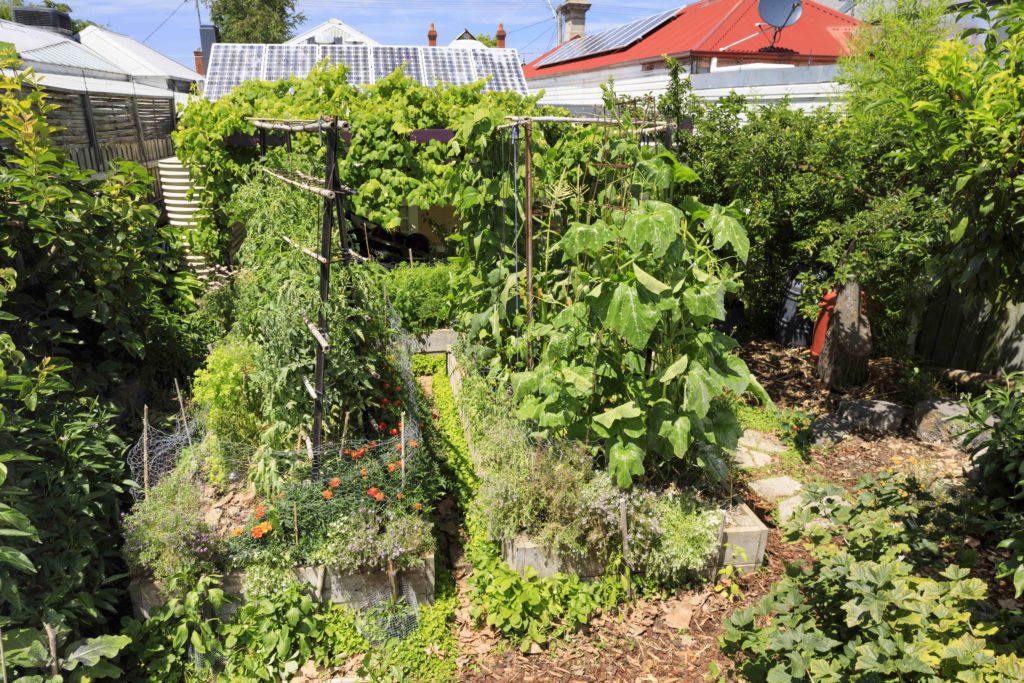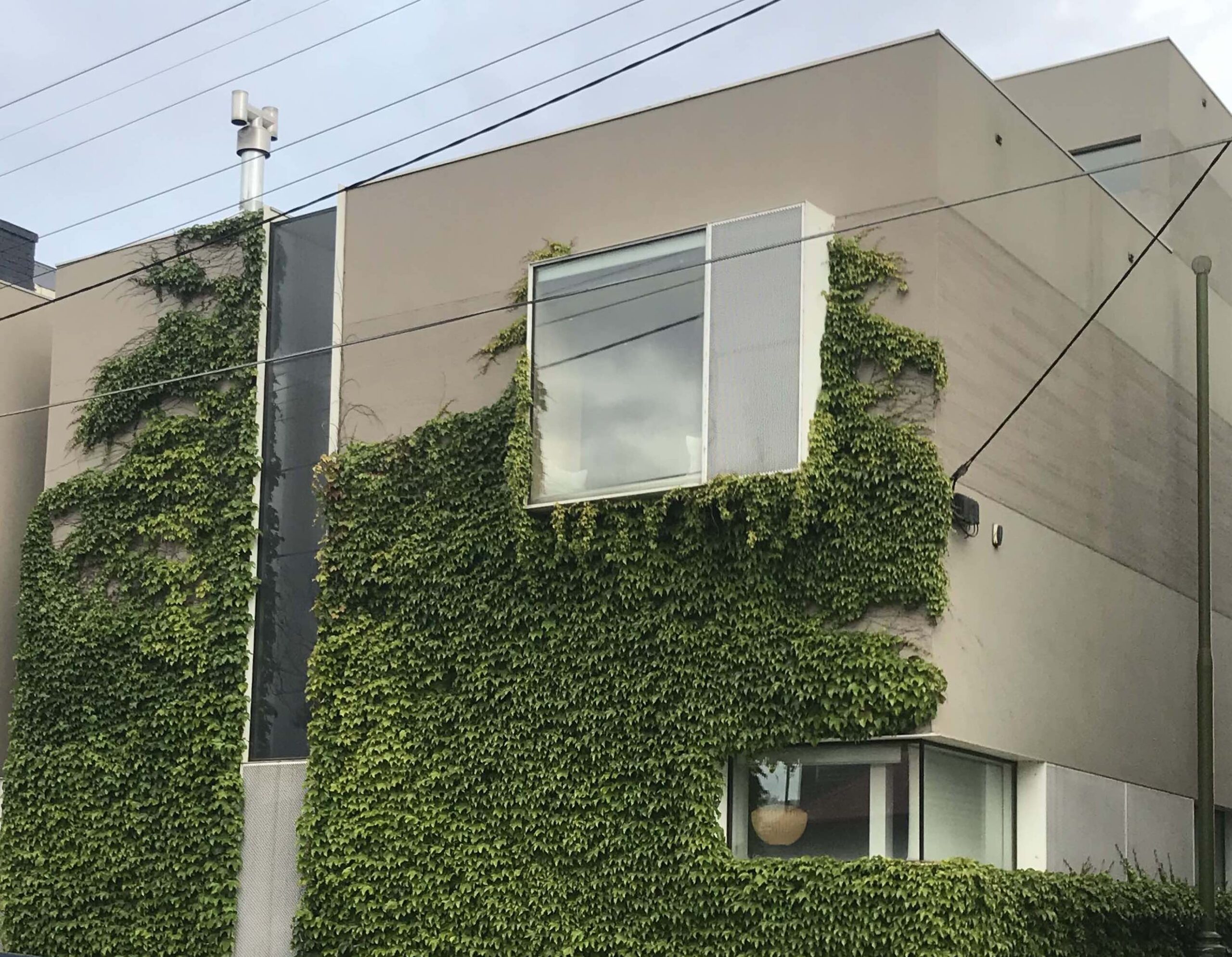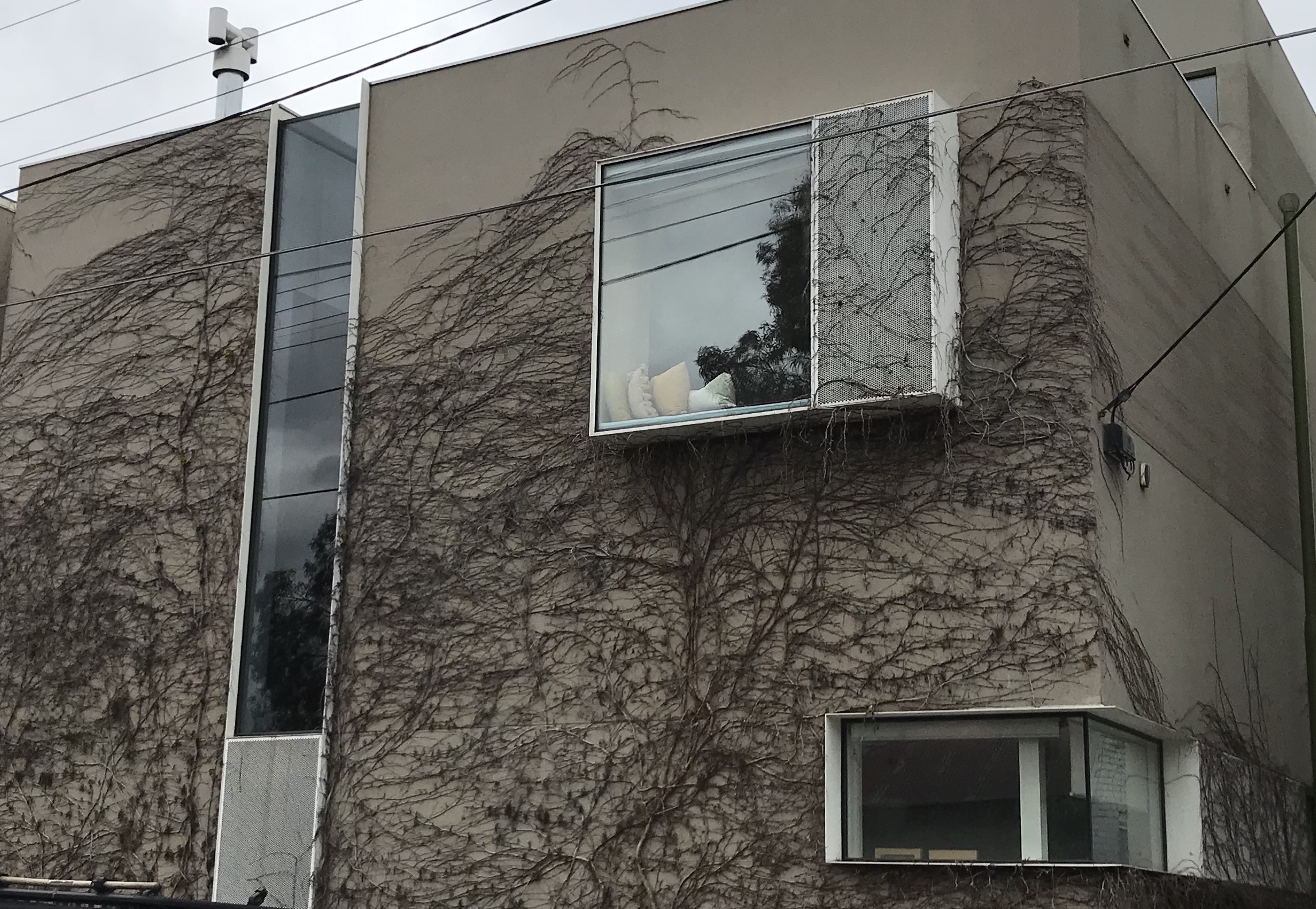Landscaping for energy efficiency in Melbourne
Notes by My Smart Garden 2023
Shelter your home with trees and vines to stay comfortable and save on your energy bills
Our city is becoming hotter. This is due to climate change, as well as the ‘urban heat island effect’ created by materials like concrete, brick and bitumen that store heat from the sun. Landscaping is a simple and inexpensive way to increase the energy efficiency of your home, while creating other benefits like food and habitat. A clever garden design can modify temperatures in and around your home by as much as 5 to 6 degrees Celcius (Ossola et al 2020). In Melbourne’s climate, the goal is to maximise exposure to winter sun, minimise summer sun, reduce the surrounding air temperature during hot weather, shelter the house from unpleasant winds and channel cooling summer breezes into the house.


On the north side of this Melbourne home, a grape vine creates a shaded outdoor living space that transforms into a sunny courtyard when the leaves drop in autumn. Permeable paving on the pathway lets rainwater soak into the ground, and the garden, irrigated mostly with rainwater and greywater, cools the surrounding air and creates habitat for many native insects while producing food for the household.
Moderate sun throughout the year
- Plant deciduous trees, or vines on a pergola on the northern side of the house to allow entry of winter sun and warm winter breezes.
- Design deciduous leaf coverage right to the ground on eastern and western side of the house to prevent summer sun from reaching walls or windows at low angles in the morning or afternoon. Hedges, shrubs or vines on vertical frames can be used.
- Position evergreen trees to avoid blocking winter sun by planting them further away from or on the southern side of the house. Pruning can sometimes be used to shape existing trees for better winter sun access by, for example, removing lower limbs on a tall tree to allow low sun angles to reach the house.
- Renters can use pots and portable trellises. Annual vines or perennials that die back to a clump in winter are quick to establish and easy to relocate.
- Plants that self-adhere to walls (eg. Boston ivy) can create cheap and simple green façades that shade and insulate masonry walls.

The north wall of this home is covered by Boston ivy. This tough vine self-adheres to masonry walls to create a green façade that insulates and cool walls in summer, while losing leaves in winter to let the sun through.
Reduce ground temperatures and glare
- Use groundcover plants or lawn to reduce glare and ground temperatures.
- Irrigated plants provide the greatest cooling benefit. Use rainwater or greywater (from laundry, shower or bath) and design paved areas to shed water into the garden where possible.
- Avoid large areas of paving where possible, and use permeable paving to allow rainwater infiltration.
- Shade paved areas in summer with deciduous trees or vines on a pergola.

Deflect or channel winds
- Winds are influenced by local buildings and landforms, but in Melbourne generally the most unpleasant hot winds in summer are from the north or north-west, while the most unpleasant cold winter winds are usually from the south or south-west. Conversely, pleasant cooling summer breezes tend to come from the south or south-west, while pleasant warm winter breezes come from the north or north-west.
- Evergreen trees, shrubs and vines on the southern side of houses can create shelter from the coldest winter winds, but risk blocking cooling summer breezes as well which also tend to come from the south. Balance is needed here and care must be taken not to obstruct south-facing doors and windows that can be opened to channel cool breezes into the house in summer.
Create multiple benefits with food and habitat plants
Any tree or vine can create shade and cool your landscape, but you can design for multiple benefits by choosing food plants (including native food plants) for a home grown harvest, or indigenous plants to create habitat for wildlife.
| Deciduous food plants for summer shade and winter sun | |
|---|---|
| Trees | Apple, Pear, Quince, Pomegranate, Persimmon, Mulberry, Plum, Apricot, Nectarine and Peach. |
| Perennial vines | Hardy kiwi, Thornless brambleberries. Hops and choko (die back to a clump in winter). |
| Annual vines | Pumpkin, climbing zucchini (eg. tromboncino) |
| Evergreen food plants for summer and winter shade | |
|---|---|
| Spreading groundcovers | Warrigal greens (Tetragonia tetragonioides), bower spinach (Tetragonia implexicoma), spreading violets, spreading wild strawberries, prostrate rosemary, oregano, thyme. |
| Trees | Citrus (eg. lemon, lime, orange, mandarin etc), feijoa, olive, carob (need male and female or hermaphrodite variety for pollination), macadamia, avocado (need both A and B types for pollination eg. Hass and Bacon). |
| Perennial vines | Passionfruit. |
| Evergreen native plants for summer and winter shade | |
|---|---|
| Spreading groundcovers | Warrigal greens (tetragonia tetragonioides), bower spinach (tetragonia implexicoma), kidney weed (dichondra repens), ruby saltbush (enchalyena tomentosa), running postman prostrate (kennedia prostrata), creeping boobialla (myoporum parvifolium). |
| Shrubs | Gold dust wattle (acacia acinacea), fragrant saltbush (rhagodia parabolica), hop goodenia (goodenia ovata), austral indigo (indigofera australis) |
| Perennial vines | Small leaved clematis (clematis microphylla), false sarsaparilla (hardenbergia violacea), native raspberry (rubus parvifolius) |
| Trees | Lightwood (acacia implexa), silver banksia (banksia marginata), river bottlebrush (callistemon sieberi), rosemary grevillea (grevillea romarinifolia) |
Important reminders
- Remember to always Dial Before You Dig to check for underground services.
- Check the mature size of plants to ensure they will not outgrow your space, and look up sun, moisture and maintenance requirements.
- Avoid planting trees directly against houses or fences to allow for maintenance and prevent structural damage.
Further information
Check out this excellent reference for planting diagrams and species lists.
For more information on sustainable gardening see My Smart Garden and the Sustainable Gardening in Hobsons Bay booklet.
Reference:
Ossola, A., Staas, L., Leishman, M.R., 2020. Urban Trees and People’s Yards Mitigate Extreme Heat in Western Adelaide. Macquarie University, North Ryde, Sydney, Australia.


